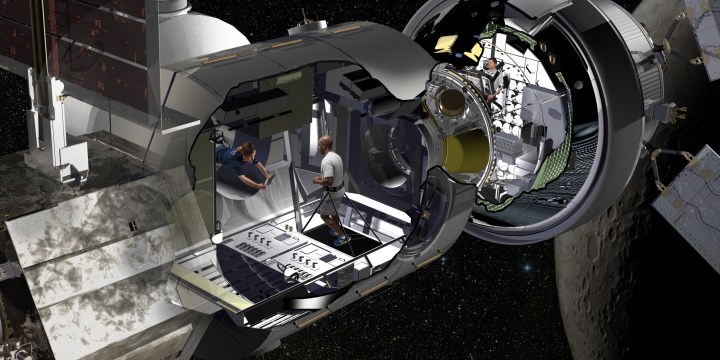
But six companies are on the case, commissioned by NASA to develop living quarters for its astronauts in its Next Space Technologies for Exploration Partnerships (NextSTEP). Lockheed Martin recently showed off a habitat concept it is developing for the agency. A prototype of the cislunar habitat, which the company calls Deep Space Gateway, will be made of repurposed space shuttle and will soon be developed as a prototype at the Kennedy Space Center in Florida.
“It is easy to take things for granted when you are living at home, but the recently selected astronauts will face unique challenges,” Bill Pratt, Lockheed Martin NextSTEP program manager, said in a statement. “Something as simple as calling your family is completely different when you are outside of low Earth orbit. While building this habitat, we have to operate in a different mindset that’s more akin to long trips to Mars to ensure we keep them safe, healthy and productive.”
The Deep Space Gateway will combine old elements with new, extending Lockheed Martin’s Phase I concept to Phase II, which will use mixed reality and rapid prototyping to explore the concept further over the next 18 months. The company will focus on refurbishing the Donatello Multi-Purpose Logistics Module, which was used to bring cargo to the International Space Station.
“We are excited to work with NASA to repurpose a historic piece of flight hardware, originally designed for low Earth orbit exploration, to play a role in humanity’s push into deep space,” Pratt said. “Making use of existing capabilities will be a guiding philosophy for Lockheed Martin to minimize development time and meet NASA’s affordability goals.”
Despite being designed with a human crew in mind, the spacecraft will be equipped to function autonomously, as it will be left uninhabited for months on end as the crew explores the Red Planet.
“Because the Deep Space Gateway would be uninhabited for several months at a time, it has to be rugged, reliable and have the robotic capabilities to operate autonomously. Essentially it is a robotic spacecraft that is well-suited for humans when Orion is present,” Pratt said. “Lockheed Martin’s experience building autonomous planetary spacecraft plays a large role in making that possible.”
Editors' Recommendations
- Watch SpaceX’s Crew-4 astronauts arrive at new home in space
- Watch the ISS attach its new doorway to space
- ISS astronauts take delivery of a shiny new space toilet
- How to keep astronauts sane: The psychology of long-duration space missions
- The next challenge for getting to Mars: What happens to the human body in space


